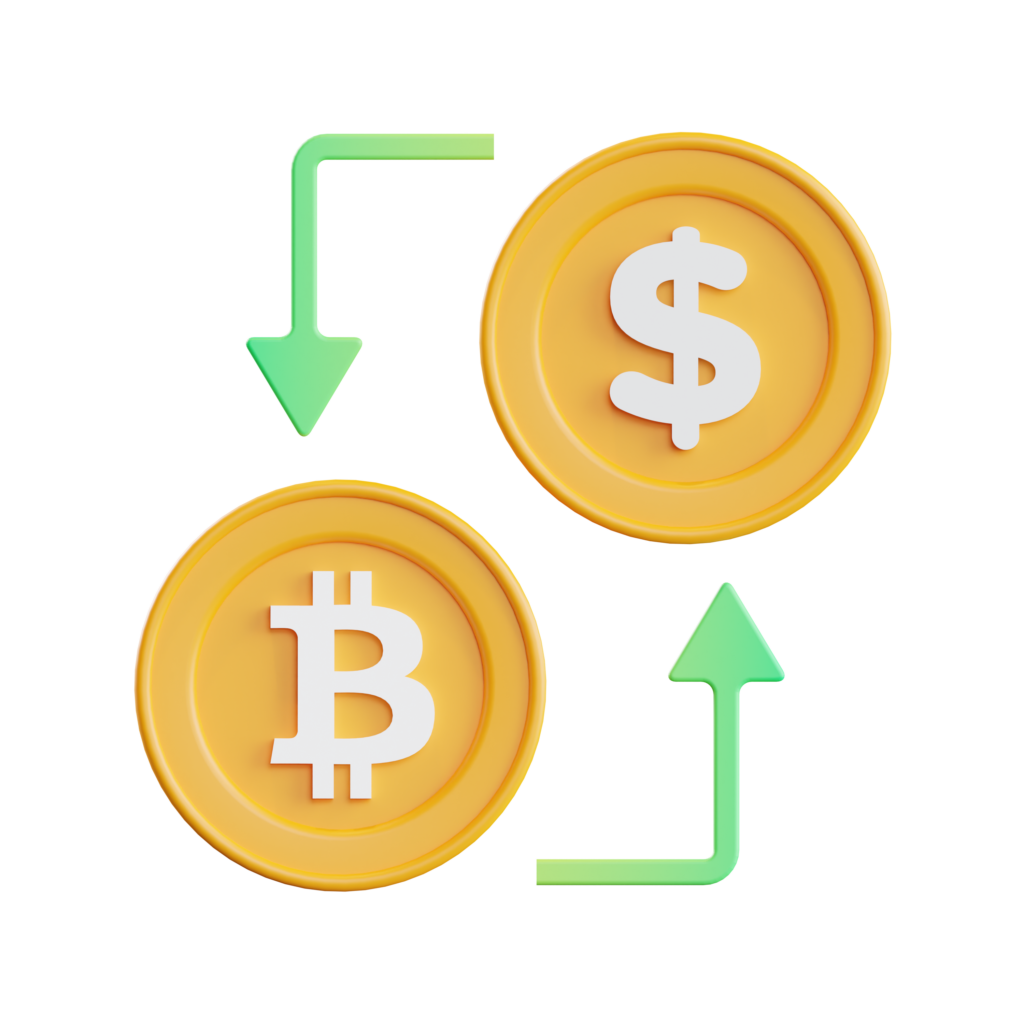
One of the most significant aspects of Bitcoin’s ecosystem is trading, where individuals and institutions buy and sell this digital asset for profit. Bitcoin trading operates on a decentralized network, offering participants the opportunity to capitalize on price fluctuations.
Bitcoin trading involves buying and selling Bitcoin (BTC) to make a profit from the price fluctuations in the market. It’s important to note that trading any cryptocurrency, including Bitcoin, can be highly volatile and risky, and it requires a good understanding of the market, technical analysis, and risk management.
So, ‘How does Bitcoin trading work? Let us explore the various types of trading, the underlying technology, and the strategies employed by traders.
What Is Bitcoin Trading?
Bitcoin trading involves the exchange of this digital cryptocurrency for other assets, such as fiat currencies or other cryptocurrencies, intending to generate profit from price fluctuations. Traders speculate on whether the price of Bitcoin will rise or fall within a specific timeframe. The trading process occurs on cryptocurrency exchanges, which provide a platform for buyers and sellers to interact.
Before you understand the basics of ‘Bitcoin Trading’ here are some of the most common questions answered that come to the human mind first;
Is Bitcoin Trading Profitable?
The potential for profitability in Bitcoin trading is one of its main attractions. However, it’s important to note that trading carries inherent risks, and profitability is not guaranteed. While some traders have achieved significant gains, others have incurred losses. Success in Bitcoin trading requires a combination of market knowledge, disciplined strategies, and effective risk management.
How Do I Start Trading Bitcoin?
Starting your journey in Bitcoin trading involves several steps:
Educate Yourself and understand the basics of Bitcoin, blockchain technology, and different trading strategies.
Choose a Reliable and reputable cryptocurrency exchange with user-friendly interfaces, security measures, and a variety of trading pairs.
Create an Account by signing up on the chosen exchange, completing any verification processes, and securing your account with strong authentication methods.
Deposit funds into your exchange account using accepted payment methods.
Research and analysis is what you need to do! Study market trends, learn technical and fundamental analysis, and develop a trading plan.
Start Small to begin with! Begin with a small investment to familiarize yourself with trading dynamics and minimize potential losses.
Execute Trades: Place orders based on your analysis, using market or limit orders.
Monitor, adjust regularly and review trades, adjust strategies as needed, and stay updated with market news.
Here’s a basic overview of How Bitcoin trading works for experienced traders.
Choosing a Trading Platform
You need to select a cryptocurrency exchange where you can trade Bitcoin. Some popular exchanges include Coinbase, Binance, Kraken, and Bitfinex. Make sure to choose a reputable exchange with good security measures.
Creating an Account
You’ll need to sign up and create an account on the chosen exchange. This typically involves providing your email address, creating a password, and verifying your identity through KYC (Know Your Customer) procedures.
Depositing Funds

Once your account is set up and verified, you’ll need to deposit funds into your exchange account. This can usually be done using bank transfers, credit/debit cards, or other payment methods supported by the exchange.
Market Analysis
Before making any trades, it’s important to analyze the market. Traders often use technical analysis (analyzing price charts and patterns) and fundamental analysis (considering news, events, and macroeconomic factors) to make informed decisions.
Placing Orders
There are several types of orders you can place when trading Bitcoin:
Market Order
This type of order is executed immediately at the current market price. It’s suitable when you want to enter or exit a trade quickly.
Limit Order
With a limit order, you specify the price at which you’re willing to buy or sell Bitcoin. The order will only be executed when the market reaches your specified price.
Stop Order
A stop order becomes a market order when the price reaches a certain level (stop price). It’s often used to limit potential losses or to enter a trade once a certain price level is breached.
Executing Trades
Once you place an order, the exchange’s trading engine matches your order with available buy or sell orders from other users. When a match is found, the trade is executed, and your account balance is updated accordingly.
Managing Trades
After a trade is executed, you can monitor the market and decide when to close the position. Traders often use various strategies to manage their trades, including setting profit targets and stop-loss levels to mitigate potential losses.
Exiting Trades
You can close a trade by placing an opposing order to the one you initially placed. For example, if you bought Bitcoin, you would sell it to exit the trade. The difference between the buy and sell price determines your profit or loss.
Risk Management
Trading carries inherent risks due to the volatility of cryptocurrency markets. It’s crucial to manage your risk by not investing more than you can afford to lose, diversifying your investments, and using stop-loss orders.
Continuous Learning
Bitcoin trading requires continuous learning and adaptation to changing market conditions. Staying informed about news, trends, and developments in the cryptocurrency space is essential.
Remember that successful trading requires a combination of knowledge, strategy, and emotional discipline. It’s recommended to start with a small investment and gradually increase your exposure as you gain experience and confidence.
Can Bitcoin Be Converted to Cash?

Yes, Bitcoin can be converted into traditional fiat currencies like the US Dollar, Euro, or Japanese Yen. This conversion occurs on cryptocurrency exchanges, where you can sell your Bitcoin for fiat and then withdraw the fiat to your bank account. The ability to convert Bitcoin to cash provides liquidity and allows traders to realize their gains.
Factors Influencing Bitcoin’s Price Movements
Several factors contribute to the volatility of Bitcoin’s price:
Market Demand and Supply: Like any asset, Bitcoin’s price is influenced by the balance between buyers and sellers in the market.
Regulatory Developments: Government regulations and policies can impact investor sentiment and the legal status of Bitcoin.
Market Sentiment: News, social media trends, and public perception can lead to rapid price fluctuations driven by emotional reactions.
Technological Advances: Upgrades to the Bitcoin network, as well as innovations in blockchain technology, can influence price trends.
Macro-Economic Factors: Economic events, inflation concerns, and currency devaluation in traditional financial markets can affect Bitcoin’s appeal as a store of value.
Institutional Interest: Increased participation from institutional investors, such as hedge funds and corporations, can impact demand and price.
Halving Events: Bitcoin’s programmed supply reduction, known as halving, occurs approximately every four years and historically has affected its price due to reduced issuance.
Bitcoin Basics and Trading Exchanges
Bitcoin is a digital currency that operates on decentralized blockchain technology, ensuring the security, transparency, and immutability of transactions. Trading involves the exchange of Bitcoin for other currencies, assets, or commodities. Bitcoin trading primarily takes place on online platforms called cryptocurrency exchanges. These exchanges serve as marketplaces where buyers and sellers can connect to execute trades.
Types of Bitcoin Trading
Spot Trading: Spot trading involves the direct purchase or sale of Bitcoin at its current market price. It’s the simplest form of trading and the basis for all other trading types. Traders can choose from various order types, such as market orders (executed at the current market price) or limit orders (executed when the price reaches a specified level).
Futures Trading: Futures trading involves contracts that obligate the trader to buy or sell Bitcoin at a predetermined price on a specific future date. This allows traders to speculate on the price movement without owning the actual asset. It’s important to note that futures trading introduces additional risks due to leverage, which can amplify both gains and losses.
Options Trading: Options trading grants traders the right, but not the obligation, to buy or sell Bitcoin at a predetermined price within a specified time frame. This provides more flexibility compared to futures trading, as traders can choose not to exercise the option if it’s not profitable.
The Role of Exchanges
Cryptocurrency exchanges play a pivotal role in facilitating Bitcoin trading. They provide an interface for users to create accounts, deposit funds, place orders, and execute trades. Exchanges also offer market data, charts, and analysis tools that aid traders in making informed decisions. Notable exchanges include Coinbase, Binance, Kraken, and Bitfinex.
Bitcoin Trading Strategies
Day Trading: Day traders seek to profit from short-term price movements within a single trading day. They make multiple trades throughout the day, capitalizing on small price fluctuations. This strategy requires quick decision-making, technical analysis skills, and a deep understanding of market trends.
Swing Trading: Swing traders aim to capitalize on medium-term price trends that typically last a few days to a few weeks. They use technical and fundamental analysis to identify potential entry and exit points, aiming to capture larger price movements.
HODLing: This strategy involves holding onto Bitcoin for the long term, irrespective of short-term price fluctuations. HODLers believe in the long-term value appreciation of Bitcoin and are not concerned with short-term volatility.
Arbitrage: Arbitrage involves exploiting price discrepancies of Bitcoin across different exchanges. Traders buy Bitcoin at a lower price on one exchange and sell it at a higher price on another, pocketing the price difference as profit.
Technical Analysis and Fundamental Analysis
Bitcoin trading often involves two main approaches to analyzing market trends and making trading decisions: technical analysis and fundamental analysis.
Technical Analysis: This approach involves studying historical price and volume data, as well as chart patterns and indicators. Traders use technical analysis to identify trends, support and resistance levels, and potential entry or exit points.
Fundamental Analysis: Fundamental analysis considers external factors that can influence Bitcoin’s price, such as news, regulatory developments, macroeconomic trends, and technological advancements. Traders using this approach aim to assess the intrinsic value of Bitcoin.
Risk Management and Psychology
Bitcoin trading, like any form of financial trading, involves risks. Traders need to employ effective risk management strategies to protect their capital and minimize losses. Additionally, understanding trading psychology is crucial; emotions like fear and greed can influence decision-making and lead to irrational trading choices.
The Bottom Line
When you’re getting into trading, it’s really important to approach it thoughtfully. That means taking your time to do thorough research and truly understanding how the market works so that you can make smart and successful trading decisions. Trading Bitcoin can be an exciting way to potentially make a profit because its price goes up and down quite a bit. However, even though there’s potential to make money, it’s crucial to be careful and wise about it. This involves doing a lot of research, creating solid strategies, and managing the risks involved.
Starting in trading begins with learning all you can about it, choosing a reliable place to trade, and becoming skilled at analyzing how the market is moving. You can exchange your Bitcoin for regular cash by using certain trading platforms, which makes it more usable in everyday transactions. If you can understand the different factors that cause the price of Bitcoin to go up and down, you’ll be better equipped to navigate the changing market landscape. Whether you’re experienced in trading or just beginning, the world of Bitcoin trading is full of opportunities to explore and learn from. It offers potential rewards but also comes with challenges that you need to be aware of.